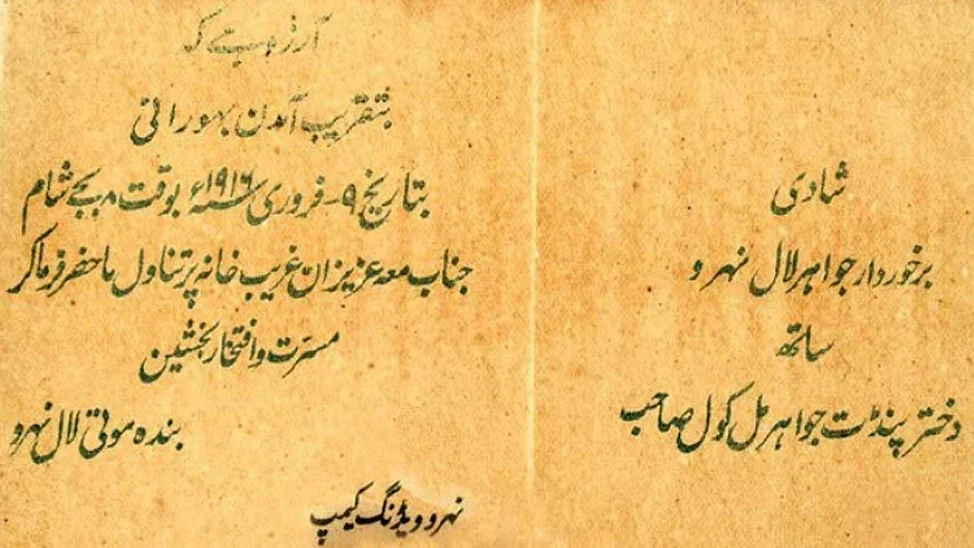Nehru’s Urdu connection & his wedding cards
Three different types of cards printed in chaste Persianised Urdu were distributed as wedding invites of Jawaharal Nehru, who was a connoisseur of Urdu poetry

While several efforts are underway to rejuvenate the charm of the Urdu language in the land of its birth, there was a time when it represented the cosmopolitan culture of the country. The wedding cards of India’s first Prime Minister Pandit Jawaharlal Nehru stand testimony to this fact.
Jawaharlal Nehru married Kamala Kaul in February 1916 at the age of 26. Soon after wedding dates and wedding venues were fixed for the three-day ceremony, three different kinds of cards were distributed as wedding invites. The cards printed in chaste Persianised Urdu had even the date, year and time written in Persian script with a finesse which seems to be a rarity these days.
Even though Kamala Nehru hailed from a conservative Kashmiri Brahmin family, Jawaharlal Nehru’s family is said to have a more westernised lifestyle. Curiously, the name of bride was not mentioned on any of the wedding cards, as per the culture during those days.
The first invitation card that was printed on behalf of Motilal Nehru, father of Jawaharlal Nehru, reads: “It is requested that on the wedding day of my son Jawaharlal Nehru scheduled to be held on February 7, 1916 at 4 pm, your good-self along with family are invited for a tea party with the groom at the humble house of our in-laws. Regards: Motilal Nehru. Nehru Wedding Camp, Alipur Road Delhi. (Iltizahai kay ba-rozshaadi, barkhurdar Jawaharlal Nehru, ba-tareekh February 7, 1916, ba-waqt 4 bajayshaam, JanabMaaAziazangareebkhana par chaa-noshi farmaa ka, ba-humrahinosha, dolatkhanaSamdhiyaan par tashrifsharifarzaanifarmaain. Banda: Moti Lal Nehru, Nehru Wedding Camp, Alipur Road Delhi).”
The second card—which was printed on behalf of Motilal Nehru to invite guests at his Allahabad residence, Anand Bhavan, reads: “It is expected that you and your family members will participate in the ceremony of the scheduled marriage of my son Jawaharlal Nehru with the daughter of Jawaharmal Mull Kaul, resident of Delhi on February 7, 1916 and on February 8 and 9, 1916; and give us the privilege of your auspicious company. Regards: Moti Lal Nehru. Anticipate your kind response. Anand Bhavan Allahabad. (Tamannahaikiba-takareeb shaadi, barkhurdar Jawaharlal Nehru, saath, dukhtar Jawaharmal Mull Kaul, ba-mukaam Delhi, ba-tareekh February 7, 1916 aurba-tareekhmabaadba-tawareekh 8 aur 9 February 1916, Janaab Maa Azizaan, shirkat farmaakar musarrataur Iftikhar bakshain. Banda-Motilal Nehru, Munatzir jawaab. Anand Bhavan. Allahabad).”
Similarly, the third card was an invitation to the welcome ceremony for the new bride, Kamla Nehru. Spread over two pages, the invite had a mention of wedding feast. “Marriage of my son Jawaharlal Nehru with the daughter of Jawaharmal Mull Kaul. It is expected that on the arrival of bride on February 9, 1916 at 8 pm, you and your family join us for the feast at our humble house and give us the privilege of your auspicious company. Regards: Motilal Nehru. Nehru Wedding Camp, Alipur Road, Delhi. (Shaadi barkhurdar Jawaharlal Nehru. Saath, dukhtar Jawaharmal Mull Kaul, Aarzoo hai kay ba-takareebaamdan bahurani, tareekh February 9, 1916, ba-waqt 8 bajay shaam Janab Maa Azizaan GareebKhana par tanavul ma hazar farmakar musarrataur Iftikhar bakshain. Banda-Motilal Nehru. Nehru Wedding Camp. Alipur Road, Delhi).”
The cards provide an interesting insight into Nehru family’s special bond with Urdu. In spite of malicious propaganda of Muslim League against the Congress, which generated a fear psychosis among a section of Muslims that the latter was a party of Hindus, Jawaharlal Nehru was hailed as a statesman by most Urdu poets—including many who migrated to or chose to stay in Pakistan after Partition. Many Urdu poets including Ali Sardar Jafri, Sahir Ludhianvi and Kaifi Azmi—not only expressed grief at his demise but also wrote poems to pay him tributes.
Besides Urdu, Nehru was well versed in other languages such as English, Hindi and Sanskrit. Prominent among other poets who were his friends included Firaq Gorakhpuri, Josh Malihabadi, Jigar Moradabadi, Saghar Nizami and Harivansh Rai Bachchan.
Even after becoming the Prime Minister, he would religiously attend an Urdu mushaira (symposium) as and when possible.
Widely spoken in states like Jammu and Kashmir, Uttar Pradesh, Bihar, Maharashtra, Andhra Pradesh, Karnataka and Jharkhand, Urdu is counted as a major Indian language. Even in the Hindi belt, Urdu is widely spoken in Rajasthan, Madhya Pradesh, Haryana, Delhi and Uttrakhand, unlike other languages that enjoy constitutional status.
While the government is yet to release the language-related data results of the 2011 Census, in census 2001, Urdu—which ranked 6th among scheduled languages—was declared as mother tongue by nearly 52 million people, over 5 per cent of the national population.
Interestingly, when Pakistan came into existence, it declared Urdu as its national language even though it was spoken by only 5 per cent of its population. According to Census of India of 2001, India has 122 major languages and 1599 other languages.
Follow us on: Facebook, Twitter, Google News, Instagram
Join our official telegram channel (@nationalherald) and stay updated with the latest headlines
Published: 16 Nov 2017, 8:57 AM
